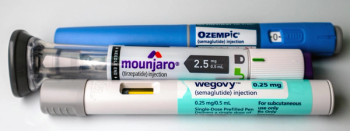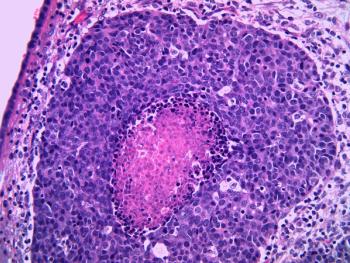
Gedatolisib Triplet Shows Significant PFS Benefit in HR+/HER2– Breast Cancer
Key Takeaways
- Gedatolisib combined with fulvestrant and palbociclib significantly improved mPFS in HR+/HER2– ABC patients post-CDK4/6 inhibitor therapy.
- The triplet therapy achieved a mPFS of 9.3 months, outperforming fulvestrant alone and the doublet regimen.
Gedatolisib shows promise in enhancing progression-free survival for HR+/HER2– breast cancer patients resistant to standard therapies, as revealed in ESMO 2025.
Gedatolisib (PF-05212384; Celcuity, Inc) plus fulvestrant (Faslodex; AstraZeneca) and palbociclib (Ibrance; Pfizer Inc) met its primary end point of median progression-free survival (mPFS) in the VIKTORIA-1 trial (NCT05501886). The data were presented at the European Society For Medical Oncology 2025 Congress in Berlin, Germany.1
Hormone receptor-positive (HR+)/HER2-negative (HER2–) metastatic breast cancer (BC) represents the most prevalent subtype, comprising approximately 72.7% of all cases. Managing this population remains challenging, as tumors with HER2 alterations often exhibit aggressive behavior, underscoring the urgent need for more effective treatment options.2
In patients with HR+/HER2– advanced breast cancer (ABC), resistance to first-line endocrine therapy and CDK4/6 inhibitors frequently develops, often driven by dysregulation of the PI3K/AKT/mTOR signaling pathway.
In the randomized, open-label phase 3 VIKTORIA-1 trial, gedatolisib in combination with fulvestrant and palbociclib met its primary end point of mPFS, demonstrating its potential in the treatment of patients with HR+/HER2–/PIK3CA wild-type ABC who progressed during or after CDK4/6 inhibitor therapy plus an aromatase inhibitor (AI). Researchers randomized 392 patients to receive 28-day treatment cycles of either3:
- Triplet therapy: gedatolisib plus palbociclib and fulvestrant
- Doublet therapy: gedatolisib plus fulvestrant
- Fulvestrant alone
Dosing was as follows: gedatolisib 180 mg intravenously once weekly for 3 weeks, palbociclib 125 mg orally once daily for 21 days, and fulvestrant 500 mg intramuscularly every 2 weeks during cycle 1, then every 4 weeks thereafter.3
The co-primary endpoints were PFS assessed by blinded independent central review (BICR), first comparing the triplet regimen to fulvestrant alone, and, if significant, comparing the doublet to fulvestrant. Statistical analyses used a stratified log-rank test. Secondary endpoints included overall survival (OS), safety, and response rates.3
At the median follow-up of 10.1 months, the data showed a superior mPFS of 9.3 months for gedatolisib plus palbociclib and fulvestrant compared with fulvestrant alone (2 months; HR, 0.24; 95% CI, 0.17-0.35; P < .0001) and gedatolisib plus fulvestrant (7.4 months; HR, 0.33; 95% CI, 0.24-0.48; P < .0001). The PFS benefit was consistent across pre-specified subgroups.3
The overall response rate (ORR) was 32% for the triplet regimen (including 1 complete response), 28.3% for the doublet, and 1% for fulvestrant alone. Interim overall survival (OS) analyses showed hazard ratios of 0.69 (95% CI, 0.43–1.12) for the triplet and 0.74 (95% CI, 0.46–1.19) for the doublet.3
Safety findings were consistent with the known profiles of the individual agents, with few patients discontinuing treatment due to adverse events (2.3% for the triplet and 3.1% for the doublet). Hyperglycemia occurred in 9.2% and 11.5% of patients, respectively, with grade 3 events reported in 2.3% of patients across both gedatolisib-containing groups.3
The VIKTORIA-1 findings highlight gedatolisib’s potential to address a critical therapeutic gap for patients with HR+/HER2– ABC who develop resistance to endocrine therapy and CDK4/6 inhibition. These results support continued exploration of gedatolisib-based regimens as a strategy to extend the benefits of targeted therapy in this challenging population.
REFERENCES
1. Gedatolisib plus fulvestrant with or without palbociclib vs standard-of-care for the treatment of patients with advanced or metastatic HR+/HER2- breast cancer (VIKTORIA-1) (VIKTORIA-1). Clinicaltrials.gov. Updated June 24, 2025. Accessed November 6, 2025. https://clinicaltrials.gov/study/NCT05501886
2. Gerlach A. Patritumab deruxtecan meets primary end point in ICARUS-BREAST01 trial. Pharmacy Times. September 9, 2025. Accessed November 6, 2025. https://www.pharmacytimes.com/view/patritumab-deruxtecan-meets-primary-end-point-in-icarus-breast01-trial
3. Hurvitz S, Layman R, Curigliano G, et al. LBA17 - Gedatolisib (geda) + fulvestrant ± palbociclib (palbo) vs fulvestrant in patients (pts) with HR+/ HER2-/PIK3CA wild-type (WT) advanced breast cancer (ABC): First results from VIKTORIA-1. Presented at: European Society For Medical Oncology 2025 Congress. October 17-21, 2025. Berlin, Germany. Abstract LBA17.
Newsletter
Stay informed on drug updates, treatment guidelines, and pharmacy practice trends—subscribe to Pharmacy Times for weekly clinical insights.

















































































































































































































